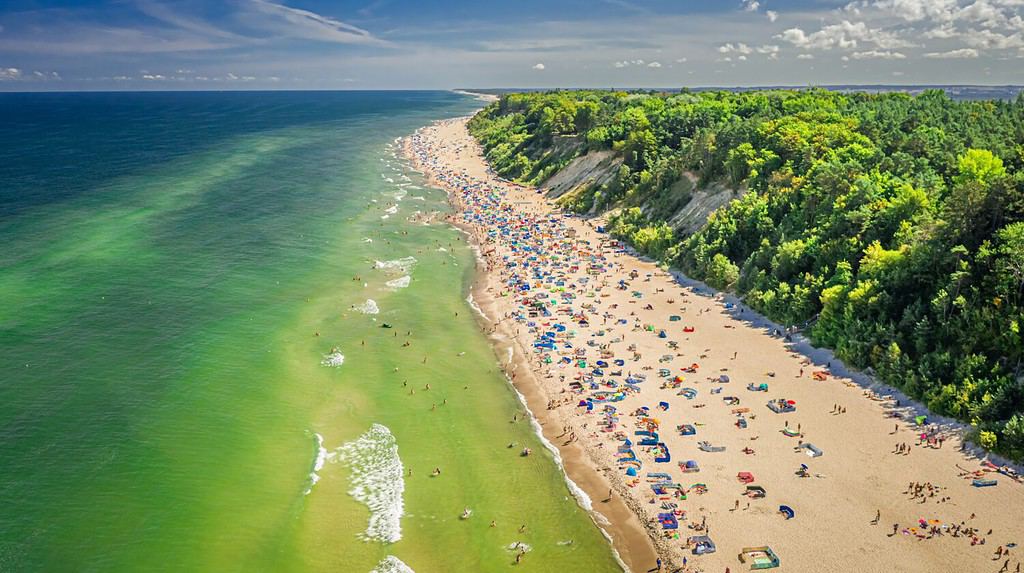The Baltic Sea is one of the most unique bodies of water in the entire world. The sea is a brackish body of water. What’s brackish? The definition of brackish water means that the particular body of water is more saline than freshwater, but less saline than other bodies of water that are normally saline.
The Baltic Sea is also home to both saltwater and freshwater marine life. Furthermore, the history of the Baltic Sea rivals the other bodies of water scattered throughout the world. But how did the Baltic Sea get its name?
Let’s take a look at how the Baltic Sea got its name. We will explore its origin and meaning, the wildlife living there, and the environmental threats it currently receives.
Fast Facts About the Baltic Sea

The Baltic Sea borders nine countries: Finland, Estonia, Latvia, Lithuania, Russia, Poland, Germany, Denmark, and Sweden.
©Juan_Hernandez/Shutterstock.com
The Baltic Sea is a shallow, brackish body of water. It borders nine countries and another five are in the basin area of the sea. It has a maximum length of 995 miles and a maximum width of 120 miles. Its total surface area is 146,000 square miles. A relatively shallow body of water, the Baltic Sea has an average depth of 180 feet and its maximum depth is 1,506 feet. Lastly, the Baltic Sea has a coastline of 5,000 miles.
Origins of the Sea’s Name?
The Baltic Sea hasn’t always been called Baltic. And for years, it wasn’t called Baltic at all. It wasn’t until the 1600s that the name “Baltic” stuck with the sea. Way back when Greek and Roman powers ruled Europe, the Roman historian Tacitus called it the Suebic Sea and the Alexandrian mathematician called it the Sarmatian Ocean.
During the 11th century, the German chronicler Adam of Bremen referred to it as the Baltic Sea. The reasoning behind why it was called that was because the Germanic world belt was used for the Danish straits (the entrance of the beginning of the Baltic Sea). This, of course, is all speculation because even Adam of Bremen stated that the sea “stretched through the land as a belt.” There’s another hypothesis that the Baltic Sea comes from a Proto-Indo-European root word that means white or fair. This could be because of two other bodies of water that are also named after colors, the Red Sea and the Black Sea.
Nevertheless, it was called by various names for centuries until the Middle Ages. Today, the Baltic Sea is also currently referred to by other names. In Estonia, it is called “the West Sea” or “Evening Sea.” In Finland or Germanic languages, it is also referred to as “East Sea.”
Wildlife in the Baltic Sea

The Baltic Sea boasts the title of the largest inland brackish sea in the world.
©Shaiith/Shutterstock.com
Even though pollution and climate change are threatening the survival of the Baltic Sea, it is still home to an abundance of wildlife. The Baltic Sea is brackish which means that both marine and freshwater animals are living in its depths. There are over 2,000 species of wildlife that make the Baltic Sea its home. The species that coexist with one another have fascinated scientists for a very long time.
You can find a variety of fish in the Baltic Sea including the Atlantic herring, European flounder, Atlantic cod, European perch, and many more. The most common species you will find in the Baltic Sea is the blue mussel, but there are also shore crabs and starfish living there. Lastly, you can also spot orcas, beluga whales, humpback whales, and minke whales.
Pollution Affecting the Sea

The Baltic Sea’s serious pollution problems are mainly caused by humans.
©Agata Kowalczyk/Shutterstock.com
Climate change is ravaging the world and threatening people’s existence more and more. The main culprit in why climate change exists and its drastic speed is none other than humans, more specifically human pollution. This affects everything, including bodies of water.
The Baltic Sea is one of the most polluted bodies of water in the world. The sea has been a dumping ground for surrounding countries since World War II. You can find so many artifacts in the depths of the sea — airplanes, warships, and other war materials. But there is also something more dangerous in the water and that includes microplastics, agricultural runoff waste, and chemicals in the sea. The pollution has gotten so bad that there are dead zones in the sea and those areas smell like rotten eggs because of the pollutants’ bad nutrients.
Conclusion
And there you have it, that’s how the Baltic Sea got its name. Today, the Baltic Sea is a unique body of water that is extremely important to tens of millions of people. It borders nine countries and serves as a basin for another five. People rely on the Baltic Sea, but as people continue to pollute this beautiful body of water, it will continue to go down an irreversible path where much of the water will be unusable. One only hopes the governments of these bordering countries become proactive to save the Baltic Sea.
The photo featured at the top of this post is © Aastels/Shutterstock.com
Thank you for reading! Have some feedback for us? Contact the AZ Animals editorial team.






